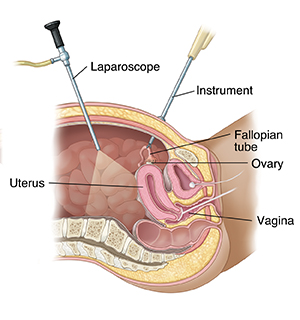Your Laparoscopic Tubal Sterilization Procedure
Getting ready for surgery
Your health care provider will talk with you about preparing for surgery. You will need to:
-
Sign a sterilization consent form. This often must be signed weeks in advance.
-
Have tests, such as blood tests. These help show your general health.
-
Tell your provider if you take any medicines, supplements, or herbal remedies. You may need to stop taking some of them before surgery.
-
Follow any directions you are given for not eating or drinking before surgery.
-
Arrange for someone to give you a ride home after surgery.
-
Arrive at the hospital or surgical facility on time. You will be asked to sign certain forms and change into a patient gown.
During surgery
-
You’ll be given an IV (intravenous) line and medicine that lets you sleep during surgery.
-
After the anesthesia takes effect, your surgeon makes a small incision in or below your navel.
-
Your abdomen is inflated with small amounts of gas. It lifts the abdominal wall. This makes it easier to guide instruments to the tubes.
-
Your surgeon then inserts the laparoscope to view the organs in your abdomen.
-
Surgical instruments may be placed through the laparoscope or through other small incisions.
-
The fallopian tubes are blocked using one of several methods (see below).
-
After the tubes are blocked, your surgeon slowly releases the gas and removes the instruments.
-
The incisions are closed with stitches, staples, or glue.

Blocking the fallopian tubes
To block the tubes, your surgeon will use one of these methods:
-
Cauterization uses electrical current to heat and seal each tube. The sealed ends of the tubes may then be cut.
-
A ring or band closes each tube. This keeps egg and sperm from being able to meet. It's left in place.
-
A clip shuts off each tube, blocking the passage of sperm and egg. It's left in place.
After surgery
You’ll rest in the recovery area until you feel well enough to go home. Be sure to have someone available to drive you. You will likely feel tired, so take it easy for the rest of the day. Ask your health care provider when it’s okay to resume your normal routine. For the first few days you may have:
-
Pain at the incision sites—use pain relief medicine if needed.
-
Shoulder pain that is caused by the gas used during surgery (you may also have a gassy or bloated feeling).
-
A small amount of vaginal bleeding (use pads instead of tampons).
-
Nausea or vomiting.
-
Dizziness.
-
Sore throat.
When to contact your doctor
Contact your health care provider if you have:
-
Redness, drainage, or swelling at the incisions.
-
A fever of 100.4° F ( 38°C ) or higher, or as directed by your provider.
-
Trouble urinating.
-
Smelly or unusual vaginal discharge.
-
Severe abdominal pain or bloating.
-
Nausea or vomiting that doesn't go away.
-
Persistent or heavy bleeding. This means more than 1 pad an hour for 2 hours.
-
A missed period, irregular bleeding, or severe abdominal pain. These symptoms can be signs of a tubal pregnancy.
Online Medical Reviewer:
Daphne Pierce-Smith RN MSN
Online Medical Reviewer:
Rajadurai Samnishanth Researcher
Online Medical Reviewer:
Raymond Turley Jr PA-C
Date Last Reviewed:
2/1/2025
© 2000-2025 The StayWell Company, LLC. All rights reserved. This information is not intended as a substitute for professional medical care. Always follow your healthcare professional's instructions.